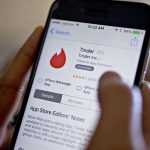Love And Sex Are A Swipe Away But Finding Friends Digitally Is Still Hard
In 2016, finding a romantic partner or a casual fling through a smartphone app is more or less mainstream. A study published in 2013 found about a third of newly married couples met online, and a Pew Research Center survey released last year found most American adults agree that “online dating is a good way to meet people.”
But what about meeting people for purely platonic purposes—finding a concert buddy, tennis partner, or just a new friend to grab coffee with? There are quite a few digital services designed to connect people with new friends; dating site Bumble made headlines by launching a BFF mode last month. But even some “friending” services’ creators acknowledge online friendmaking isn’t nearly as widely embraced as actual online dating.
“We knew that the stigma associated with making friends online was going to be our biggest hurdle,” says Joel Kliksberg, the founder and CEO of Palaround. The company operates a friend-finding app with a Tinder-like swipe interface.
“The friending space is the next frontier,” he claims, “but it’s very much in its infancy. Telling a friend, ‘Hey, check out this friending app’ is not really that comfortable, yet.”
There’s simply a social stigma attached to announcing too loudly that you need to make friends. And, says Nermin Jasani, the founder of the now-defunct, women-only friend-finding site Lumelle, we don’t even really have the right vocabulary with which to discuss meeting up with potential new pals.
“I don’t think our conservations have updated to that point where you can go out on ‘friendship dates’ and say, ‘I’m going out on a date with a girl to be friends with,’” says Jasani.
Lumelle hosted member meetups in New York and Los Angeles to try to overcome some of that awkwardness, and there were definitely people who understood the value of the service, Jasani says. Jasani herself got the idea for the company when she moved to New York City for a job after law school upstate; after a couple of years, she still hadn’t made many friends in the city.
“I thought this was kind of a concentrated regional problem, specifically to the United States and New York,” she says. “Then I started getting emails from women in Australia and Buenos Aires and Africa.”
Her company matched women based on interests, geographical proximity, age, and other factors, and encouraged them to meet up at group outings for activities like rock climbing, golfing, and painting.
“The questions that we asked are pretty basic—are you willing to travel, what kind of a friend are looking for, are you looking for a BFF or just someone to hang out with once in a while,” she says. “You might have a girl who’s single and one in a relationship, and their needs are completely different in terms of what they’re looking for.”
The service did bring people together—she remembers two women who met at a rock-climbing event who made plans to go trapezing, something both had always wanted to do—but she ultimately found it hard to get enough participation to interest potential investors, which itself made it hard to fund new features for the app in order to attract new users.
“I faced a huge chicken-and-egg problem,” she says. Part of the problem, too, was that potential investors just didn’t understand why young women would see a need for the app.
“Honestly a lot of the investors are older investors, so their way of making a friend is going to a coffee shop or a bar and saying hello or being introduced through their significant other, or even work friends,” she says.

But Jasani and her target customers didn’t really go to bars alone; many of them are single and many prefer to keep their personal and professional lives relatively separate. And while urban coffee shops might once have been neighborhood community centers featuring cozy couches like the ones made famous in Central Perk on TV’s Friends, nowadays they’re closer to coworking spaces. Customers are often there to work or study, not talk to strangers.
“Walk into a coffee shop right now, and you won’t see a single person who’s not on a device,” she exclaims. “It’s just not an approachable environment.”
Another now-shuttered service, called “Let’s At,” which let users propose activities that other people could join, faced similar issues, says founder Greg Buckner.
“We didn’t end up getting as much traction as we hoped—we got a lot of interest but it was kind of hard to grow the user base,” he says. “I think it’s difficult to build platforms that require people to meet in person. The core value of the app doesn’t really happen [until] people meet in real life, and there’s a lot of friction around that.”
People signed up, but member surveys indicated few of them were actually meeting up with each other. And adding new features, like letting users quickly swap phone numbers or share more information in their profiles, only boosted actual connections a few percentage points. The company launched in summer of 2014 and shut down about a year ago, Buckner says.
“We were bootstrapping, and it just got to a point where we thought we probably weren’t going to raise,” he says.
Still, the need persists for a way for people to connect with new contacts, believes Palaround’s Kliksberg, citing research that shows about half of Americans don’t have a close confidante outside their own families. His company is currently marketing a licensed version of its app to help organizations, like conference and festival organizers and alumni groups, allow participants to swipe and make new contacts within their own networks.
In the original version of the app, the site separates users by gender to reduce the risk of unwanted non-platonic advances, similar to women-only services like Lumelle and recently launched apps Monarq and Hey! VINA.
Party with a Local, which connects travelers and newly relocated people with long-term residents looking for a night out, actively discourages users from trying to use it to find one-night stands, and encourages members to report inappropriate messages and photos.
“Maybe the intent is to meet someone, but it’s sometimes much more comfortable to do that in a platonic way, or a nightlife way in our case, and maybe something happens down the track,” says founder and CEO Dan Hennessy.
The Amsterdam-based service has found success in Europe and in Brazil, as well as in big U.S. cities like Los Angeles, San Francisco, and New York, and it’s currently launching a “Pals” feature which will send a monthly email suggesting potential connections, he says.
“We’re going to be wanting to constantly improve the matching algorithm and qualitative feedback if people actually meet up,” he says.
Another service, called Skout, puts less emphasis on meeting up and more on forging pen pal-style connections, according to founder and CEO Christian Wiklund. Members do use it to find dates, but many just chat and post to Skout’s newsfeed-style interface, which shows updates from both local users and members across the world.
“I think one thing that sticks out with our engagement is that the average message travels over 1,000 miles,” he says. “More than half of all messages are between continents, which is not very useful if you’re going to find someone locally to date.”
Skout helped forge 500 million new connections between users last year, Wiklund claims. And while there are some rudimentary search features, there are no matchmaking algorithms—it’s deliberately random and serendipitous, providing users with a steady stream of potential new friends.
“There’s always someone out there you can chat with,” he says. “For each new connection we can form, we’ve done something good.”
But while Wiklund emphasizes the potential value of smartphone pen pals—”I have plenty of online friends that I’ve never met and I value them as much as my friends that I have locally,” he says—it’s safe to say those looking for real-life activity partners don’t yet have any long-established, household-name solutions the way singles have go-to sites like Match, OkCupid, Tinder, and eHarmony.
But, suggests Buckner, the creator of now-shuttered Let’s At, that could all change in the future, just as online dating rapidly shifted from seeming creepy to being widely embraced (and a $2 billion industry).
“Maybe you could say that we’ll be able to match people better using AI, but I have a feeling that it’s more just like a cultural or societal thing—at some point people will be ready for an app like this, and the founders will package it up in a way that will be really compelling to people,” he says. “I think there’s just going to be some point where one of these apps will tap into the zeitgeist.”
Fast Company , Read Full Story
(117)














